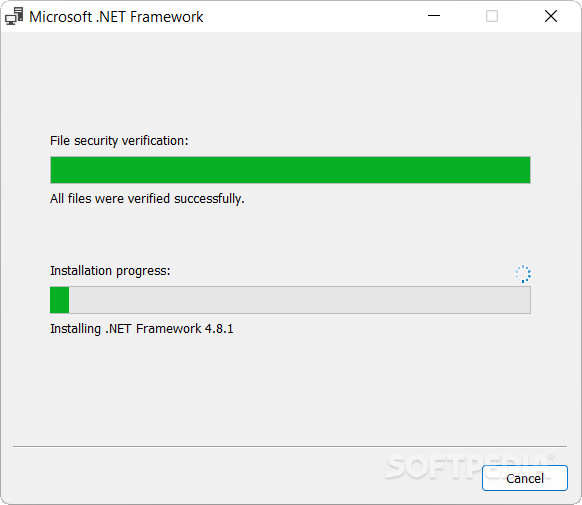Microsoft’s comprehensive and consistent programming model
The Microsoft .NET Framework 4 redistributable package installs the .NET Framework runtime and associated files that are required to run and develop applications to target the .NET Framework 4.
The .NET Framework is Microsoft’s comprehensive and consistent programming model for building applications that have visually stunning user experiences, seamless and secure communication, and the ability to model a range of business processes.
The .NET Framework 4 works side by side with older Framework versions. Applications that are based on earlier versions of the Framework will continue to run on the version targeted by default.
The Microsoft .NET Framework 4 provides the following new features and improvements:
· The .NET Framework 4 works side by side with the Framework version 3.5 SP1. Applications that are based on earlier versions of the Framework will continue to run on that version. Just a subset of functionality is shared by all versions of the Framework.
Innovations in the Visual Basic and C# languages, for example statement lambdas, implicit line continuations, dynamic dispatch, and named/optional parameters.
· The ADO.NET Entity Framework, which simplifies how developers program against relational databases by raising the level of abstraction, has many new features. These includes persistence ignorance and POCO support, lazy loading, test-driven development support, functions in model, and new LINQ operators.
· Enhancements to ASP.NET:
New JavaScript UI Templates and databinding capabilities for AJAX.
New ASP.NET chart control.
· Improvements in WPF:
Added support in Windows Presentation Foundation (WPF) for Windows 7 multi-touch, ribbon controls, and taskbar extensibility features.
Added support in WPF for Surface 2.0 SDK.
New line-of-business controls including charting control, smart edit, data grid, and others that improve the experience for developers who build data centric applications.
Improvements in performance and scalability.
Visual improvements in text clarity, layout pixel snapping, localization, and interoperability.
· Improvements to Windows Workflow (WF) that let developers to better host and interact with workflows. These include an improved activity programming model, an improved designer experience, a new flowchart modeling style, an expanded activity palette, workflow-rules integration, and new message correlation features. The .NET Framework also offers significant performance gains for WF-based workflows.
· Improvements to Windows Communication Foundation (WCF) such as support for WCF Workflow Services enabling workflow programs with messaging activities, correlation support, durable two-way communication and rich hosting capabilities.
· Additionally, .NET Framework 4 provides new WCF features such as service discovery, router service, simplified configuration and a number of improvements to queuing, REST support, diagnostics, and performance.
· Innovative new parallel programming features such as parallel loop support, Task Parallel Library (TPL), Parallel LINQ (PLINQ), and coordination data structures which let developers harness the power of multi-core processors.
Additional Requirements for Server Installation
If you have to perform a server installation, your computer must have the following software in addition to the basic requirements:
· Internet Information Services (IIS) version 6.0 or later. To access the features of ASP.NET, IIS with the latest security updates must be installed before the .NET Framework is installed. ASP.NET is supported only on Windows XP Professional, Windows Server 2003, Windows Server 2008, and Windows Server 2008 R2 RC.
· Recommended) Microsoft Data Access Components 2.8 or later
· Note: Most users do not have to perform a server installation. If you are unsure whether to perform a server installation, just perform a basic installation.
The Microsoft .NET Framework 4 Server Core installer package downloads the .NET Framework 4 components required to run on Windows Server 2008 R2 SP1 and higher for Server Core role installation.
When you’re running .NET Framework 4 applications on Server Core, only Server Core-based features will work, while client applications features such as Windows Presentation Foundation(WPF) and ClickOnce deployment are not supported on Server Core.
Requirements:
· Minimum: Pentium 400 MHz 96 MB RAM
· Recommended: Pentium 1 GHz or higher 256 MB or more RAM
· Windows Installer 3.1 or later
· Internet Explorer 5.01 or later
What’s New in This Release: [ read full changelog ]
Improvements in Common Language Runtime (CLR) and Base Class Library (BCL) :
· Performance improvement including better multicore support, background garbage collection, and profiler attach on server.
· New memory mapped file and numeric types.
· Easier debugging including dump debugging, Watson minidumps, mixed mode debugging for 64 bit and code contracts.
· Innovations in the Visual Basic and C# languages, for example statement lambdas, implicit line continuations, dynamic dispatch, and named/optional parameters.
· Improvements in Data Access and Modeling
· The Entity Framework enables developers to program against relational databases using .NET objects and Language Integrated Query (LINQ). It has many new features, including persistence ignorance and POCO support, foreign key associations, lazy loading, test-driven development support, functions in the model, and new LINQ operators. Additional features include better n-tier support with self-tracking entities, customizab…
source:www.softpedia.com
Download


 08:30
08:30
 Unknown
Unknown


 Posted in:
Posted in: 









0 comments:
Post a Comment